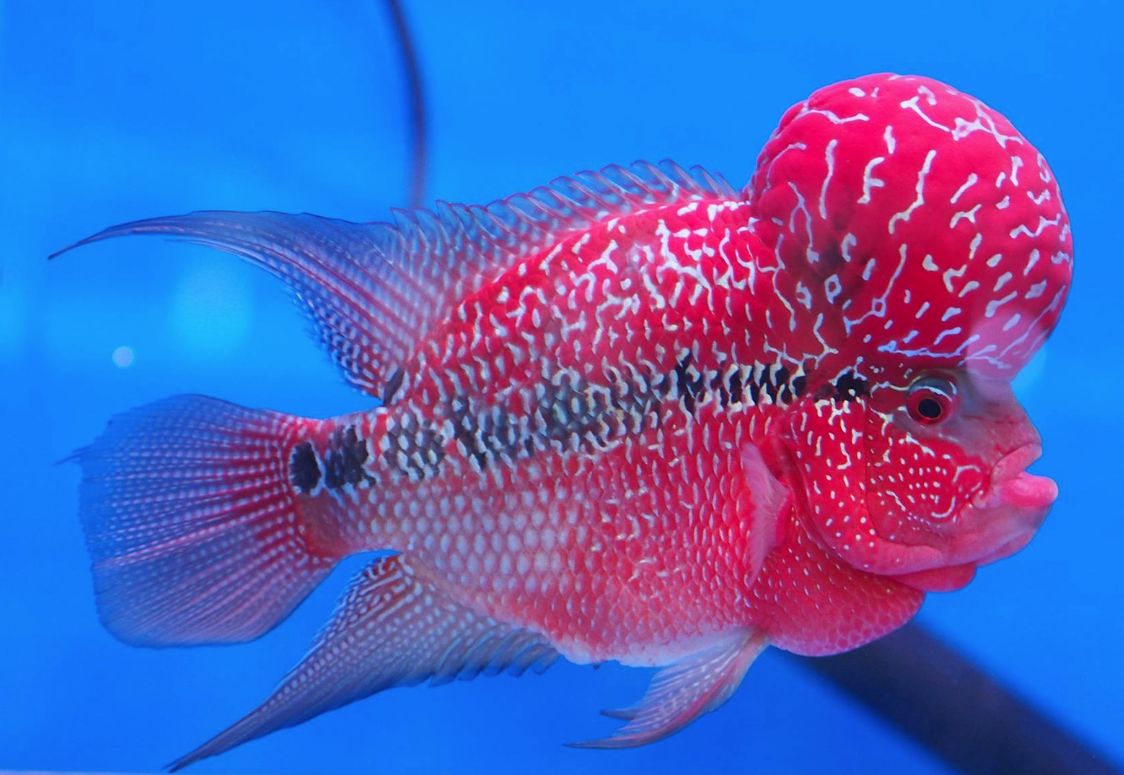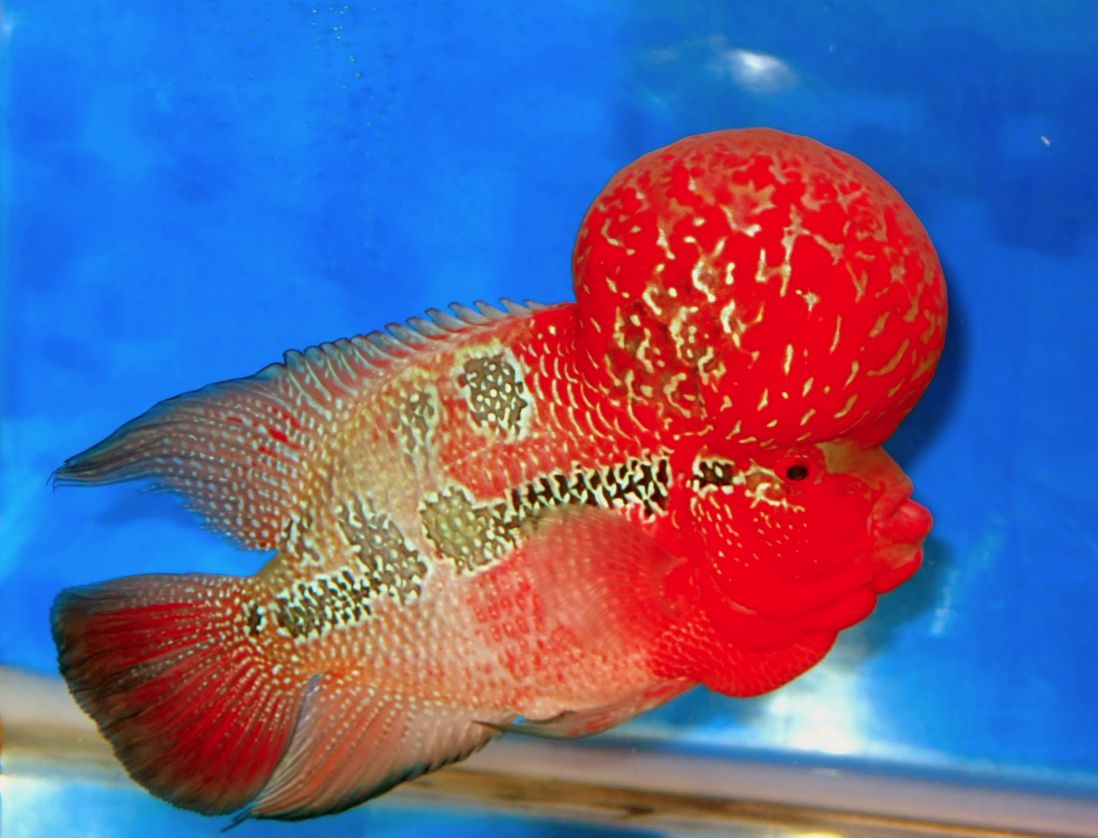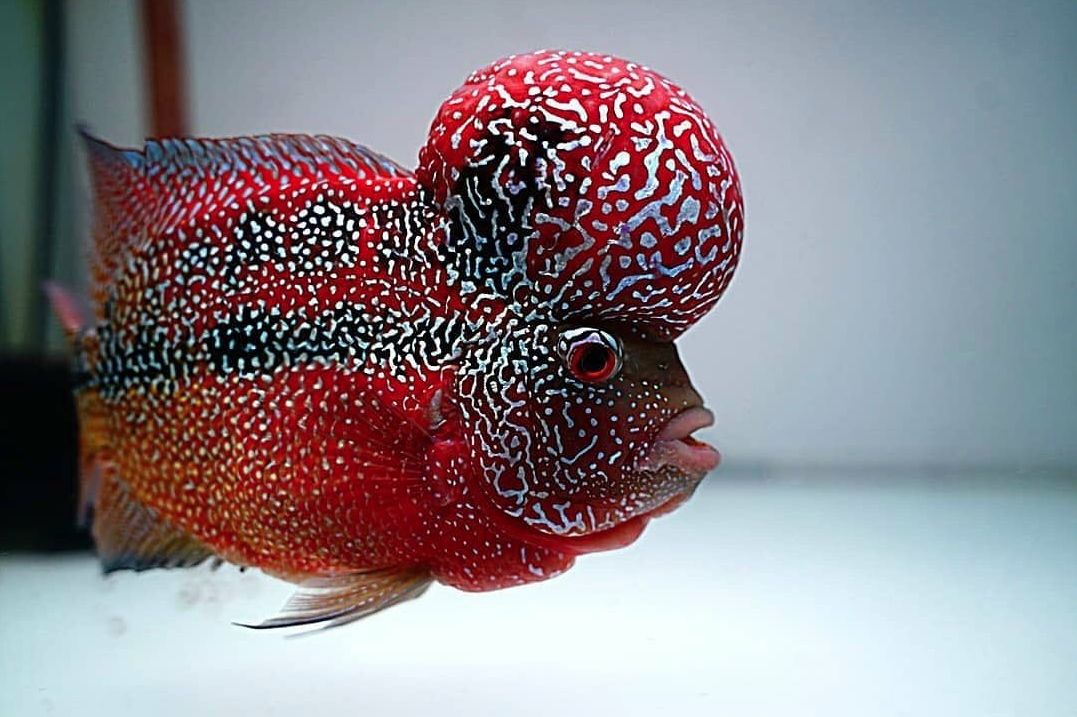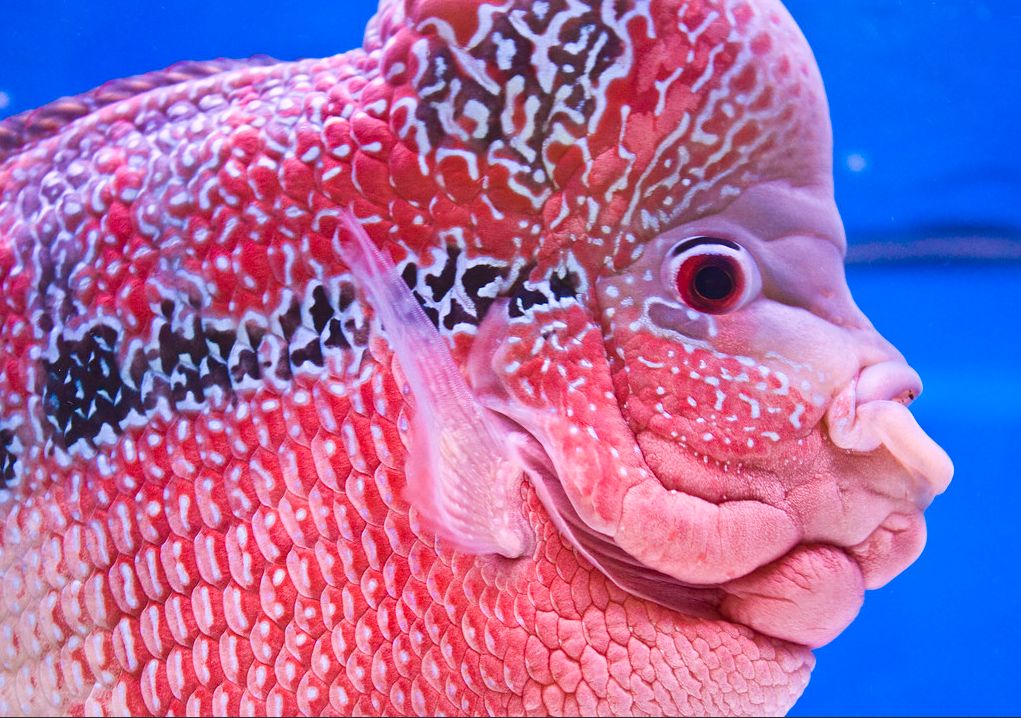The flowerhorn is a captivating fish known for its distinctive appearance, vibrant colors, and intriguing behavior. Aquarium enthusiasts who choose to keep a flowerhorn often find it a rewarding experience due to its unique personality and striking look. However, before acquiring one, it’s essential to understand its specific needs and characteristics.
In this article, we’ll explore the origins of the flowerhorn and whether it can be found in the wild. We’ll also discuss the challenges of keeping this fish, its lifespan, and how to provide proper care. Additionally, you’ll learn about suitable feeding practices and selecting the best tank mates to ensure a thriving environment for your fish.

Contents
History
The flowerhorn is a fascinating hybrid cichlid fish that does not occur naturally in the wild. It was meticulously bred in the 1990s by crossing various cichlid species, creating a unique and visually striking fish with an unusual appearance. Unlike many other cichlids, which can breed with different cichlid types, the flowerhorn’s distinct traits are the result of selective breeding.
Not all hybrids achieve success; some may lack vibrant coloring or become sterile. However, there are notable exceptions, such as the flowerhorn and the parrot cichlid, both of which are celebrated examples of successful hybrid breeding. The flowerhorn, in particular, was first bred in Malaysia during the 1990s. It gained attention for its distinctive head hump, leading to its nickname “Karoli,” meaning “fighting ship.”
The exact combination of cichlids used to create the flowerhorn remains somewhat mysterious, known primarily to the original breeders. However, it is widely believed to be a cross between Cichlasoma trimaculatum and various red terror cichlids such as Amphilophus citrinellus, Amphilophus labiatus, and Vieja synspila.
The first commercially available flowerhorn hybrid, known as Hua Luo Han, emerged around 1998. Since then, flowerhorns have gained immense popularity, especially with various morphs and hybrids, including those with pronounced forehead humps (kok) or unique body shapes.
Since 2001, flowerhorns have been a prominent feature at the “AQUARAMA” exhibition in Singapore, where they have consistently drawn global attention, overshadowing many other popular fish species. Today, some of the most sought-after hybrids include KamFa, Kamalau (KML or Golden Monkey), Zhen Zhu (ZZ), Thai Silk, Red Dragon, and Gold flowerhorn (golden base), among others.

FAQ
How big do flowerhorns get?
Flowerhorns are known for their impressive size and striking appearance. Males typically grow to a length of 12-15 inches (30-38 cm), while females are somewhat smaller, reaching 10-12 inches (25-30 cm). With the right care and environment, they can achieve substantial size, making them a standout feature in any aquarium.
The maximum size of a fish can vary based on several factors, including genetics, diet, and overall health. Proper nutrition and a well-maintained tank are crucial in helping these fish reach their full growth potential. By understanding and addressing these factors, you can ensure that your flowerhorn grows to its impressive size and remains healthy.
How long does it take for a flowerhorn to reach full size?
The flowerhorn’s growth rate is quite remarkable. During their first year, these fish can grow up to 2 cm per month. However, the rate of growth can differ from one fish to another, influenced by factors such as genetics, diet, and overall care.
On average, it takes about 1.5 to 2 years for a fish to reach its full size. The exact time can vary based on individual circumstances, including the quality of care and the fish’s environment. Providing optimal nutrition and a suitable habitat is crucial for achieving the best growth potential for your flowerhorn.
How fast do flowerhorns grow?
During their early months, flowerhorns undergo rapid growth and can achieve impressive sizes within their first year. However, as they approach maturity, their growth rate may slow down. Several factors can influence their growth, including the quality and quantity of food, tank size, and water conditions.
Even after reaching their maximum size, flowerhorns can continue to develop and change in appearance. The distinctive head hump, vibrant colors, and fin extensions often become more pronounced as the fish matures, adding to their striking presence in the aquarium.
How many years flowerhorn fish live?
Flowerhorns typically have a lifespan of 8 to 10 years, although some individuals may live longer. Their longevity is influenced by several factors, including genetics, tank conditions, and water temperature. Generally, higher water temperatures can accelerate metabolism and potentially shorten lifespan. Nonetheless, with optimal care, some flowerhorns have been known to live up to 15 years.
The key to a longer, healthier life for your flowerhorn lies in providing a high-quality diet and excellent care. Fish that receive proper nutrition and a well-maintained environment tend to thrive and live longer than those with less favorable conditions.
Are flowerhorn fish aggressive?
Flowerhorns are renowned for their aggressive behavior, a trait that has been selectively bred into them to enhance their territorial and assertive nature. This aggression is a defining characteristic of the breed.
Male flowerhorns, in particular, exhibit more pronounced aggression compared to females. They are known for being highly territorial and may engage in aggressive behaviors such as chasing, fin-nipping, and outright hostility towards other fish, especially if they view them as intruders.
To manage their aggression and ensure a harmonious tank environment, it is crucial to set up the aquarium thoughtfully. Providing ample space, hiding spots, and avoiding overcrowding can help reduce stress and mitigate aggressive behavior.
It is generally advisable to keep flowerhorns either alone or with other robust and similarly sized cichlid species that can withstand their aggressive tendencies. Mixing flowerhorns with smaller or more peaceful fish is not recommended, as it can lead to bullying and potential harm to the other tank mates.
Description
The flowerhorn is a striking American cichlid known for its large, bulky body, fan-shaped fins, and the distinctive nuchal hump, or “kok,” on its forehead. This prominent feature is a key breeding trait and is most noticeable in males, though females also possess a smaller, less pronounced hump.
The development of the kok largely depends on genetics. However, there are variations among flowerhorns: some high-end specimens are bred with exceptional humps through selective breeding and specialized diets, while lower-priced flowerhorns may have large humps due to genetic factors and pre-sale treatments with hormone-like substances. The latter approach often results in larger humps but can lead to smaller body sizes and gastrointestinal issues.
Flowerhorns are highly variable in appearance, even among individuals from the same brood. Their coloration and body shape can differ significantly. As they mature, their colors become more vivid, particularly during the reproductive stage. This makes choosing a fish with a specific color challenging if you are looking for a particular hue.
Research shows that flowerhorns can be categorized into several morphological groups, each displaying traits from their parental types. This suggests that the breeding process involved multiple lines.
Interestingly, flowerhorns undergo color changes throughout their lives. If you seek a fish with a particular coloration, it’s best to select a mature specimen. Juveniles will exhibit a range of color changes, and while this can lead to discovering an exceptionally vibrant fish, it can also mean the final coloration might differ from initial expectations.
| Characteristics | Description |
|---|---|
| Scientific Name | Hybrid cichlid (multiple cichlid species involved in their creation) |
| Size | Can reach sizes of 10 to 16 inches (25 to 40 centimeters) or more |
| Appearance | Vibrant colors, distinct nuchal hump (more pronounced in males), varied patterns and markings, elongated dorsal and anal fins |
| Aggression | Generally aggressive, especially towards smaller or more timid tank mates |
| Life Span | Average lifespan of 8 to 12 years, with proper care potentially longer |
| Temperament | Assertive and territorial, can display dominance and aggression towards other fish |
| Diet | Omnivorous, with a preference for high-quality pellets, supplemented with live or frozen foods like bloodworms, brine shrimp, and small crustaceans |
| Water Parameters | Temperature: 78°F to 82°F (25°C to 28°C), pH: 6.8 to 7.8, Ammonia/Nitrite: 0, Nitrate: below 20 ppm, General Hardness (GH): 8-12 dGH, Carbonate Hardness (KH): 4-6 dKH |
| Tank Size | Minimum tank size of 50 gallons (189 liters) for a single adult, larger tank recommended for more space and territorial needs |
| Tank Mates | Compatibility varies, but larger cichlid species and certain peaceful tank mates like Parrot Cichlids, Silver Dollars, or Plecos may be suitable |
| Decor | Rocks, caves, driftwood, artificial plants, and appropriate hiding spots are recommended |
| Maintenance | Regular water changes, efficient filtration, monitoring water parameters, and maintaining a balanced diet are important for their well-being |

Difficulties in keeping
Caring for a flowerhorn fish can be relatively straightforward, as they adapt well to various water parameters and are not particularly demanding when it comes to feeding. They will consume any protein-rich food, whether artificial or live. However, despite their seemingly beginner-friendly nature, flowerhorns present several challenges that make them less ideal for novice aquarists.
Key Considerations:
- Tank Size: Flowerhorns are large fish that require a spacious tank to thrive. Their size demands ample swimming space and appropriate tank conditions.
- Aggression and Territoriality: They are known for their aggressive and territorial behavior. It is best to keep them alone in their tank, without tank mates or even plants, to prevent conflicts. Beginners might find smaller and more peaceful cichlid species to be a better fit.
- Behavior Towards Owners: Flowerhorns can exhibit aggressive behavior towards their owners, including biting during feeding or tank maintenance. This behavior requires careful handling and caution.

Diet
Flowerhorns are known for their impressive appetite and can thrive on a varied diet, provided they are healthy. These fish will eagerly consume both live and dry foods. A well-balanced diet includes high-quality pellets specifically designed for flowerhorns, along with frozen foods like prawns or mussels. They also enjoy bloodworms, fresh sprats, calamari pieces, and low-fat fish such as goldfish.
For optimal health, choose high-quality pellets made from premium raw materials with high protein content. These pellets are specially formulated to meet the dietary needs of cichlids, with added vitamins to boost their immunity and support a long lifespan. Be cautious with homemade foods; while some aquarists use mammal meat, this can cause digestion issues and potentially lead to serious health problems for your flowerhorn.
In a community tank, flowerhorns are known for their enthusiastic feeding behavior. They will often swim quickly to the hand offering food and may even allow gentle handling, though they can bite if provoked.
A balanced diet for flowerhorns should include a mix of high-quality pellets or flakes, complemented by occasional live or frozen foods. This variety ensures they receive the necessary nutrients to maintain their vibrant colors and robust health.
Care and keeping in a tank
The first thing to do before getting a fish is to check its state (defects, bloom on its skin, fins) and activity. Body coloring is an important component, but in flowerhorn case, it may not be of crucial importance since they get their complete coloring quite late. While the fish grows, its coloring may significantly vary. It’s worth checking the breeders, not the juveniles.
Tank size
Caring for a flowerhorn is relatively straightforward due to its hardiness, but it does require significant space. As these fish grow, they can reach impressive sizes of 30-40 cm, making a spacious tank essential for their well-being.
For young flowerhorns, a tank size of around 30 gallons (113 liters) is adequate for their initial growth. However, as they mature, their space requirements increase. A minimum tank size of 50 gallons (189 liters) is recommended for a single adult flowerhorn, though larger tanks—300-500 liters (66-110 gallons)—are preferable, especially if you intend to house multiple fish or larger varieties. A spacious tank allows the flowerhorn to showcase its full beauty and maintain its health.
If you wish to keep multiple flowerhorns or pairs, it’s crucial to monitor their interactions closely. Males, in particular, can be aggressive towards females, so having a well-sized tank with ample shelters and distinct territories can help minimize conflicts.
In their native Malaysia and Thailand, flowerhorns are often kept individually in separate tanks to highlight their beauty and prevent aggression. In a well-sized tank, an adult swims gracefully and confidently, rarely hiding and often displaying its impressive size and striking appearance. Its presence adds a bold statement to any aquarium, ensuring that a large tank with a flowerhorn will never appear empty.
Water parameters
Maintaining the right water parameters is essential for the health and well-being of flowerhorn fish. Here’s what you need to know to ensure optimal conditions in your aquarium:
Temperature
Flowerhorns thrive in tropical conditions. Keep the water temperature between 78°F and 82°F (25°C and 28°C). Use a reliable aquarium heater to maintain a consistent temperature within this range.
pH Level
Flowerhorns prefer slightly acidic to neutral water. Aim for a pH level between 6.8 and 7.8. Regularly test the pH with a water test kit and make any necessary adjustments. Avoid sudden changes in pH, as they can stress the fish.
Ammonia and Nitrite
Both ammonia and nitrite are harmful to flowerhorns and should be kept at zero. Test these levels frequently, especially during the initial setup and after any major changes. Ensure your tank has efficient biological filtration and perform regular water changes to keep these toxins in check.
Nitrate
Nitrate is a byproduct of the nitrogen cycle, and while less harmful than ammonia or nitrite, it should still be kept low. Aim to keep nitrate levels below 20 ppm (parts per million). Regular water changes and effective biological filtration will help manage nitrate levels.
General Hardness (GH) and Carbonate Hardness (KH)
Flowerhorns prefer moderately hard water. Target a GH range of 8-12 dGH (degrees of general hardness) and a KH range of 4-6 dKH (degrees of carbonate hardness). Use appropriate water testing kits to monitor and adjust these parameters as needed.

Tank setup: decorations and plants
Flowerhorn likes digging tank bottom and eating the tank plants, so you aren’t likely to create some kind of nice aqua-scape with plants. While flowerhorns may uproot or damage live plants due to their digging or territorial behaviors, you can consider using artificial plants to provide a natural aesthetic. Opt for sturdy and vibrant artificial plants that can withstand the fish’s activity.
Sadly, keeping them in a planted tank isn’t likely to be a success. Everything will be dug and ruined. Even stiff-leaved plants such as Anubias fixed to a heavy snag, or a stone will not survive. These cichlids are strong enough with powerful jaws. The male can bite rather notable even for a human while the plan will fail to stand it.
Flowerhorns appreciate hiding spots and territories, so incorporating rocks and caves into the tank can provide them with suitable hiding places. Use aquarium-safe rocks or caves that have smooth edges to avoid any potential injuries. Adding driftwood or root structures can create interesting visual elements in the tank while also providing hiding spots and areas for exploration.
Make sure that rocks and other tank decorations, equipment are anchored well, and they won’t fall since flowerhorn is quite capable of turning them over.
Filtration
Flowerhorn fish thrive in a well-maintained environment with moderate water flow and clean conditions. To ensure optimal water quality, a powerful canister filter is essential for these large fish. Here’s how to keep their tank in top shape:
Filtration and Aeration: A strong external canister filter is crucial for handling the high waste output of flowerhorns. These filters efficiently remove debris and maintain clean water, which is vital for the fish’s health. Proper aeration is also important to keep the water oxygenated.
Water Changes: Regular water changes are necessary to sustain a healthy tank environment. Aim to replace up to 20% of the tank water weekly. This helps remove toxins and maintain stable water parameters.
Substrate Cleaning: Flowerhorns can be quite messy eaters, so it’s important to regularly clean the tank substrate. Use a bottom siphon to remove uneaten food and waste that accumulates on the substrate. This prevents the buildup of harmful substances and keeps the tank environment fresh.
Overall Maintenance: Consistent maintenance, including weekly water renewals and substrate cleaning, ensures that the tank remains in excellent condition and meets the flowerhorn’s high demands for water quality and purity.
Tank mates
It’s better to keep fish alone as a rare show fish. It is a rather territory-dependent fish with an aggressive temper and rather badly behaved for its tank mates (except for very big tanks). In smaller tanks, flowerhorn fish tank mates will get injured, or they will be stressed all the time. Hobbyists prefer to keep flowerhorns as solitary fish to ensure their overall health and minimize conflicts.
While flowerhorn fish are known for their aggressive behavior, it is possible to keep them with certain compatible tank mates under specific conditions. However, it is crucial to choose tank mates carefully and monitor their interactions closely to ensure the well-being of all fish involved.
The fish isn’t a good tank mate for any other fish since it’s very large, aggressive, and territory-dependent. It’s better to keep one fish alone or a fish couple, but if you still want to have tank mates – a tank should be very spacious. The fish will even attack you and bite when maintaining the tank. To decrease its aggressiveness, a spacious tank is required with lots of covers and large tank mates in it.
The following tank mates are good for fish: jaguar cichlid, oscar fish, black pacu, giant gourami. However, as a rule, those who keep flowerhorn conclude that it must live alone in a tank! Even sailfin pleco won’t survive there. My fish couple attacked a huge catfish, and they bit its eyes. I had to put the catfish in another tank. It wasn’t injured, but I didn’t want to wait till it comes to this. If there are many shelters in the tank, you can try putting adult bristlenose plecos there. They are very quick and can hide from flowerhorn. Since the latter slips at night, the catfish will have a chance to clean all the tank walls.
If you want to breed flowerhorns, remember that the fish’s aggressiveness spreads on its relatives. Carefully watch the fish couple so they won’t kill each other.
Gender differences: male vs female
Distinguishing between male and female fish can be challenging, as there is no entirely foolproof method. However, there are some physical and behavioral traits that can help differentiate them:
1. Nuchal Hump: One of the most noticeable differences is the size and prominence of the nuchal hump, the prominent bump on the forehead. Males typically develop a larger, more pronounced hump compared to females. This hump can vary in size and shape depending on the fish’s genetics and individual development.
2. Body Shape: Males often have a more elongated and streamlined body shape, while females may appear slightly rounder or more robust. This difference in body shape can be subtle but noticeable with close observation.
3. Coloration and Pattern: Both males and females can display vibrant colors and intricate patterns. However, males generally exhibit more intense and diverse coloration, with brighter reds, oranges, and blues, and more pronounced patterns. Females may have more subdued colors and less striking patterns.
4. Behavior and Territoriality: Male are usually more territorial and aggressive than females. They tend to establish territories and display dominant behaviors towards other fish. While females can also show aggression, they are typically less territorial.
5. Breeding Tubes: During the breeding season, females develop a small, tube-shaped genital opening called an “ovipositor” or “breeding tube” near their anal vent. This structure is used for spawning and is not present in males.